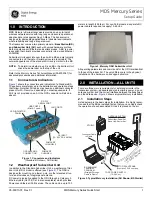
ENFORCER Wireless Request-to-Exit Plates
4
SECO-LARM U.S.A., Inc.
1.
Remove the 2 screws from the front of the plate and remove the plate from the back-box.
2.
Remove the battery clip from the 9V battery and remove the battery from the bracket.
3.
Place the new battery in the bracket and snap the battery clip to the new battery.
4.
Test the unit with the new battery. The LED should illuminate blue.
5.
Put the plate back in the housing and secure it to the back-box using the screws on the front.
Troubleshooting:
LED is red
•
9V battery is low, replace with new one
LED does not light
•
Check battery connection
•
Replace 9V battery
LED lights blue, but does not
activate lock
•
Check to make sure wireless request-to-exit plate is not housed in a
metal box
•
Test wireless request-to-exit plate closer to the receiver
•
Clear codes from receiver, and re-learn wireless plate transmitter code
Detail: Wireless Request-to-Exit Plates
Dimensions:
Notice:
The changes or modifications not expressly approved by the party responsible for compliance could void
the user’s authority to operate the equipment.
IMPORTANT NOTE:
To comply with the FCC RF exposure compliance requirements, no change to the antenna or
the device is permitted. Any change to the antenna or the device could result in the device exceeding the RF
exposure requirements and void user’s authority to operate the device.
THIS DEVICE COMPLIES WITH PART 15 OF THE FCC RULES. OPERATION IS SUBJECT TO THE FOLLOWING TWO CONDITIONS:
(1) THIS DEVICE MAY NOT CAUSE HARMFUL INTERFERENCE AND (2) THIS DEVICE MUST ACCEPT ANY INTERFERENCE
RECEIVED, INCLUDING INTERFERENCE THAT MAY CAUSE UNDESIRED OPERATION.
PITSW1 mi-SD-8 XXX.doc
Switch
9V Alkaline
Battery
LED indicator
Request
button
Battery clip
Wireless
transmitter
SD-8202GT-PEQ
shown
Red=Low Battery
1
1
/
2
”
(38mm)
4
1
/
2
”
(114mm)
2
3
/
4
”
(70mm)
2
1
/
4
”
(57mm)
Red=Low Battery
Red=Low Battery
ENFORCER
®
NOTE: Products with a model number that ends with “Q” or have a round green “Q” sticker represent RoHs compliant products.
ENFORCER
®
MANUAL
SK-910RQ / SD-8202GT-PEQ
System
These RF receivers are compatible with both code hopping and fixed-code trans. They can be used for a variety
of applications, such as allowing the same transmitter to arm/disarm a vehicle alarm and open/close a garage door
opener. The receivers come in one- or two-channel versions. Each channel can learn the codes of up to 15 different
transmitter buttons on a first-in, first-out basis.
The ENFORCER Wireless RF Request-to-Exit Buttons are the ideal solution for difficult Access Control installations. The
RTE plates combine the very best of SECO-LARM, flexible wireless solutions and reliable access control. The RTE plates
are perfect for cement or brick walls, or any other location where it is difficult to run wires.
Features:
•
Wireless RTE Plate Tx:
-
Powered by 9VDC (battery included).
-
Range up to 250 feet. 315MHz.
-
Over 68 billion (6.8x10
10
) possible codes.
-
LED to indicate transmission and low battery.
•
Stainless-steel single-gang or slim-line plate.
•
RF Receiver:
-
Powered by 11VDC ~ 24VDC or 11VAC ~ 24VAC
-
Range up to 250 feet. 315MHz
-
Memory Capacity: 15 transmitter button codes per
channel
-
Relay Contact Rating: Form ‘C’ type; 10A @ 24VDC
or 120VAC per channel
Installation
1. Mount the receiver out of sight in a location where it is not surrounded by metal, and where it is not exposed to the
weather or moisture. Metal will block the RF signal, resulting in a reduced range.
2. For best range, pull the antenna wire of the receiver as long and straight as possible. If the receiver receives
interference from local RF activity (e.g.., airport or military base), the antenna wire can be folded. DO NOT CUT THE
ANTENNA WIRE.
3. Find a suitable location for the wireless request-to-exit plate.
NOTE: Do not house the plate in a metal box, this will greatly reduce the range.
NOTE: Do not house the plate in a metal box, this will greatly reduce the range.
NOTE: Do not house the plate in a metal box, this will greatly reduce the range.
NOTE: Do not house the plate in a metal box, this will greatly reduce the range.
4.
The wireless request-to-exit plate can be either surface mounted or flush mounted.
5.
Test the operation of the wireless request-to-exit plate in the location where it will be installed.
NOTE: The wireless request
NOTE: The wireless request
NOTE: The wireless request
NOTE: The wireless request----to
to
to
to----eeeexxxxiiiitttt ppppllllaaaatttteeee ffffiiiirrrrsssstttt nnnneeeeeeeeddddssss ttttoooo pppprrrrooooggggrrrraaaam
m
m
mm
m
m
meeeedddd iiiinnnnttttoooo tttthhhheeee rrrreeeecccceeeeiiiivvvveeeerrrr bbbbeeeeffffoooorrrreeee tttteeeessssttttiiiinnnngggg.... SSSSeeeeeeee lllleeeeaaaarrrrnnnniiiinnnngggg
procedure.
procedure.
procedure.
procedure.
6.
Check and make sure the battery clip is securely connected. Then mount the wireless request-to-exit plate in the
back-box and secure it with the 2 included screws.
SECO-LARM
®




















